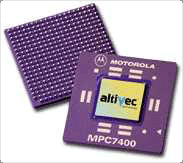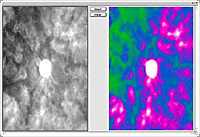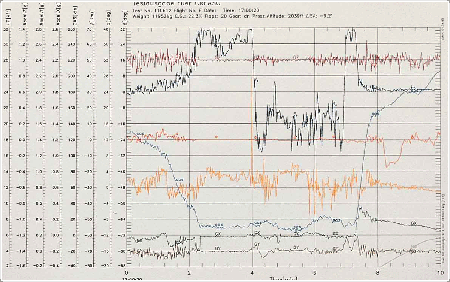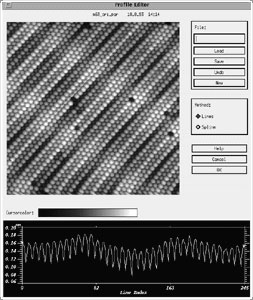- IDL을 이용한 Motorolar의 AltiVec Technology
- 독일 Dornier, GmbH의 항공기 디자인을 비행 테스트 자료 분석
- IDL을 이용한 시계열 분석 (Time Series Analysis)
- 마이크로 칩의 미세 표면 자료 분석
- 2000년 시드니 올림픽에서의 IDL 활용 사례
|
|
|
 |
|
|
Impressive Performance of Motorola's AltiVec Technology in IDL?Demos Ensures Its Place in Next IDL Release
IDL users on Apple Power Mac G4s to see huge performance gains thanks to Motorola's vector processing technology

AltiVec technology, developed by Motorola, offers an on-chip solution for high performance vector processing. Developed as an expansion to the PowerPC architecture, and integrated in Motorola's MPC7400 microprocessor, AltiVec technology is now a standard feature on all Apple Power Mac G4 machines.
The superior performance of AltiVec technology in two recent IDL demonstrations has also guaranteed its place in IDL's next release, where it promises to give IDL users on the Macintosh huge performance gains on their data processing. "When we realized that, with AltiVec technology, our customers could approach the performance levels of supercomputers on the Macintosh platform without incurring the cost to do so, we knew we wanted to make AltiVec enhancements a standard part of IDL," explained Dr. David Uhlir, director of product marketing at Research Systems.

Research Systems' developer Thierry Faucounau became interested in the AltiVec technology as soon as Motorola announced its release in 1998. "I knew I wanted to integrate the AltiVec technology into IDL because it seemed to be a very good fit and would add great value to our Macintosh products," he said.
"IDL handles lots of similar calculations on large data sets," explained Faucounau. "Since the AltiVec technology is a 128-bit vector engine, it can handle those large data sets quickly and efficiently. In addition, it is a unique vector implementation because it provides a C API so one does not have to necessarily write assembly. Many Macintosh compilers support this use of AltiVec intrinsics from high level languages such as C and C++."
In 1999, Faucounau developed "Hubble," the first IDL Demo that incorporated AltiVec technology. Originally developed for Apple's 1999 Worldwide Developers Conference, the Hubble Demo uses the visually impressive images from the Hubble Telescope to display AltiVec's superior vector processing capabilities for image processing.
To develop the Hubble demonstration, Faucounau first vectorized several basic IDL operations, such as add, subtract, multiply and divide. He then vectorized the 3D pipeline, the sequence of steps that transform vertex information - the mathematical description of a 3D image - into a visual 2D screen image, or what one sees as a 3D image on the screen. "It was surprisingly simple," said Faucounau. "It took me only a few days to modify more than 32 code paths."
"We were just astounded with the incredible increase in performance we realized from those code modifications," continued Faucounau. "We couldn't wait to show the Hubble Demo at the conference; we were sure it would have a huge impact."

At Apple's WWDC'99, Faucounau met Motorola's AltiVec Technology Product Manager, Kalpesh Gala, who saw the Hubble Demo for the first time. "I was really impressed with what Thierry had done," said Gala. "It was a beautiful demo to watch, and really showcased what the AltiVec technology can do."
"The AltiVec technology is an extremely powerful, fully independent vector processing engine which works concurrently with existing PowerPC computational engines," explained Gala. "While conventional processors generally execute one to three instructions per clock cycle, AltiVec technology enables highly parallel operations and allows simultaneous execution of more than 16 operations per clock cycle. Because IDL is an application that handles large data sets and has heavy-duty processing needs, it is a perfect fit for vectorization."
"Software such as IDL, which is optimized for the 128-bit vector processor, can realize big performance increases," added Gala. "Some algorithms have even demonstrated in excess of ten-fold increases in performance. Plus, developers can easily vectorize their applications using Motorola's AltiVec Programming Model high-level language extensions."
"Based on my experience with Thierry and Research Systems' Hubble Demo at the WWDC'99, I decided to use the demo internally as a wonderful example of a scientific application using AltiVec," continued Gala. "In fact, when I showed the demo to Motorola's CEO, Chris Galvin, he was so impressed with both AltiVec's performance and with Faucounau's application that he wanted me to continue to use it in all my demonstrations."
Meanwhile, Faucounau began working on another AltiVec IDL Demo, "Mars Flythrough." The Mars Flythrough Demo was developed for one primary purpose - Steve Jobs' keynote address at Seybold San Francisco 1999 for the Launch of Apple's Power Mac G4 desktop systems.
The Demo is a flythrough of approximately two-thirds of Valles Marineris on Mars, a large canyon system more than 2,000 miles long and almost five miles deep. "For the Mars Flythrough Demo," explains Faucounau, "I used a grayscale height map and color texture map of the entire planet to show an approach to the planet centering on the Valles Marineris as well as much of the canyon. The demo highlights both IDL's 3D surface generation capabilities and Altivec's enhanced calculations, and was done using IDL's object graphics system."

We were delighted that Steve Jobs chose our Mars Flythrough Demo to demonstrate the capabilities of Apple's new Power Mac G4," said Dr. Uhlir. "It was a perfect setting to show thousands of people just how fast IDL can perform. It was also a strong testament to our growing role as an Apple Strategic Partner."
Gala also chose to add the Mars Flythrough Demo to his AltiVec demonstrations at Motorola. "I first ran both IDL Demos in September 1999 at 'Horizons'99,' a biannual media event sponsored by Motorola, which boasts an attendance of more than 200 North American reporters, journalists and analysts," said Gala.
"I also ran the IDL Demos at Motorola's Latin America Digital DNA Congress, which was held in November 1999 and had more than 300 attendees," added Gala. "In both instances, IDL performed beautifully on the MPC7400-based desktop computer. The audiences were very impressed with how well such a data-intensive scientific application can run using Motorola's technology."
"What we've seen with AltiVec has just been incredible," said Dr. Uhlir. "Huge performance increases with little programming effort. That is exactly what our customers want. Plus, the fact that both Motorola and Apple are showcasing their technology by using our IDL Demos is proof that we are doing the right thing."
"The Macintosh is now our fastest platform for basic binary operations on arrays in IDL. That is quite a statement," continued Dr. Uhlir. "We are now actively working on vectorizing more IDL operations for our next release. IDL users on the Macintosh platform are going to see dramatic increases - anywhere from a two- to a five-fold speedup for computationally intensive tasks."
"AltiVec will definitely play an important role in IDL's future," concluded Dr. Uhlir. "We are looking forward to seeing additional performance increases as we continue to modify IDL. We are sure our Macintosh customers are going to be thrilled."
IDL is a registered trademark and ION is a trademark of Research Systems, Inc. All other products and/or brand names are the properties of their respective owners. Copyright 1999. All rights reserved.
|
|
 |
|
|
German Firm Uses IDL to Analyze Flight-Test Data and Optimize Aircraft Design
Dornier, GmbH in Oberpfaffenhofen, Germany, develops and manufactures the DO328---the quietest, most economical, and fastest (620 km/h) aircraft in its class. In their Flight Testing department, Dornier had been searching for analysis software that processes and provides graphical representation of several types of time-series data recorded during test flights.
Using IDL, Dornier developed STAUS, a software environment that includes a custom GUI for analysis, visualization, and processing of data. Developed for DEC workstations, STAUS results are output to devices such as the DECLaser 2000, DEC Printserver 40, CANON CLC 300 and HP Deskjet 1200.
To easily visualize complex interactions among numerous parameters, engineers need to define several Y-axes on a graph. Eight different measurements are displayed and compared simultaneously, enabling Dornier engineers to analyze the relationships of performance characteristics such as stress on the aircraft's structure, external air temperature and pressure, maximum takeoff weights, climbing ability, cabin pressure, and temperature.

Presentation Graphics
In order for the DO328 to meet registration specifications for the Luftfahrtbundesamt (the German equivalent of the FAA), as well as European and American authorities, Dornier needed to present publication-quality test results to officials. This was easily accomplished using the IDL graphics routines embedded in STAUS.
So test engineers don't waste time creating new layouts for data display in different formats, Dornier built a database containing more than 2,000 layouts. After selecting an appropriate layout and importing the data, STAUS users can interactively modify the graphical elements until the chart is defined.
This interactive procedure also can be executed automatically using pre-written configuration files, significantly speeding the production process. The files read the ASCII data, access the database of charts, and draw the chart when users select the "grafics" button from the application menu.
Calling External Software
STAUS allows users to visualize data from external C or FORTRAN programs, enabling Dornier to utilize previous software investments. Data sets are displayed as XY plots, in polar coordinates (with multiple Y-axes), and as 3D bars or "carpet" diagrams. Dornier also uses the data to derive new test parameters.
Initially, Dornier developed their user interface with keyboard and mouse I/O routines and windows. Since then, Dornier has built a "point and click" interface using IDL's GUI controls, resulting in fewer user errors during operation of the system.
Safe Flights
The flight performance programs produce huge data sets, displayed through several IDL applications, in graphical or tabulated form. Results are sent as encapsulated PostScript files to Dornier's graphics department to be included in pilots' flight manuals. STAUS helps ensure optimal performance based on rigorous testing and engineering analysis.
|
|
 |
|
|
New Analysis Method Developed In IDL Enhances Frequency and Time Resolutions

Time-frequency distributions are powerful tools for analysis of time-series data. However, time-series data often contain signals whose frequencies change rapidly. The traditional Fourier spectrogram has been used extensively to display the frequency content of these signal data, but can fail to simultaneously provide high time and frequency resolutions. The Wigner distribution, another method of signal analysis developed after Fourier methods, overcomes spectrographic resolution problems, but can introduce nonlinear and undesirable effects.
Dr. Amir Najmi, of Johns Hopkins Applied Physics Laboratory (JHUAPL), has focused on developing optimal processing methods for electromagnetic and acoustic data. He is primarily interested in using the Wigner distribution as a tool for time-frequency analysis and the detection of signals with rapidly changing frequency content. The challenge has been to develop custom kernel functions in software that attenuate the nonlinear artifacts of the Wigner distribution.
Speed, Efficiency and Control
Before he went to Johns Hopkins Applied Physics laboratory, Najmi had been involved in developing sophisticated seismic imaging techniques for Shell Oil Company in Houston. He found programming in FORTRAN "quite unsuitable to the work of a researcher who is thinking of new methods that require rapid implementation, testing and evaluation." Najmi continues, "I had basically given up on programming and left it to the professionals because it just was not practical in my work. It took weeks or months to try out new methods, implement, debug the programs and see the results!"
Najmi was introduced to IDL by Ray Sterner, an APL colleague and long-time IDL expert. "This was the tool I had been dreaming of. I just took off with IDL," Najmi says. "Once I have an idea, I can quickly prototype that idea and see the results almost instantly. When I am at the IDL prompt, I have complete control of the machine. I even use IDL to monitor and update my home page on the World Wide Web."
Najmi runs IDL on a Hewlett-Packard 735 workstation and exports images to a variety of Tektronics printers. In the last three years, he has written and tested more than "one hundred thousand lines of code---a task I would not have been able to complete using FORTRAN or C."
Going Beyond Tradition
To test the new kernel functions, Najmi used experimental ocean current data and digitized recordings of various whale songs. Each species of whale produces different signals that form its "sound fingerprint." These signals provided complex time-series data with rich and rapidly varying frequency content.
Processing the collected data using the Wigner distribution and newly- designed kernel functions within IDL, Najmi was able to obtain spectacular imagery and show the functionality and usefulness of the new algorithm. "IDL has allowed me to write programs for designing the kernel functions using the images of the two-dimensional ambiguity function in a completely interactive environment." This has opened up a rapid method of prototyping that Najmi calls "experimental kernel design," which will have far-reaching implications for research beyond looking at whale songs. Medical studies into the effects of drugs on patients' ECGs and EEGs represent just one possibility for advancement.
IDL's ability to import and process large data sets and visualize the results gives Najmi confidence that his efforts will not be hampered by software limitations. "In one project I have processed over sixty gigabytes of data entirely within IDL in a very timely fashion."
|
|
 |
|
|
SPM System Built in IDL Simplifies Experimental Controls and Ensures Future Extensibility

A leading developer of instruments for analyzing the properties of very small surfaces (e.g. silicon- or platinum-based microchips) is advancing scanner tube microscope design to new levels of ease and accuracy. OMICRON's (Taunusstein, Germany) latest control unit for scanning probe microscopy (SPM) is SCALA, a commercially-available hardware/software system based on UNIX workstations. SCALA meets OMICRON's customer needs by combining a modern, user-friendly graphical interface for control and data processing with proven, very high signal-to-noise ratio analog electronics.
SCALA's software was written entirely in IDL and has been developed in close collaboration with CREASO, Research Systems' German representative. Dr. Thomas Berghaus, Development Manager at OMICRON, opted for IDL as the only development software for SCALA. "It is essential for a commercial software package that the program code is compact and easy to read. This allows for efficient maintenance," Berghaus remarks. "An open program structure is a must for OMICRON. The program has to be easily extensible and only IDL complies with our strict requirements."
The VME bus, an industrial standard for multi-processor systems with excellent real-time processing capabilities, together with a powerful interface between software and hardware, guarantees fast and flexible data transfers with minimum overhead. At the heart of SCALA is a VME board implementation of a SUN SPARC single-board computer which controls the system. On-line display and basic processing is done by the SPARC processor while the connection between the SPARC computer and the hardware control, data acquisition, and buffering are handled by a Real-Time Measurement Controller (RTMC-Motorola 68010).
Powerful Command Interface
The software component of SCALA combines fast and flexible measurement control with IDL's powerful image and data processing capabilities and supports single-user and network configurations. IDL's flexible tools enabled OMICRON to design a GUI that allows users to execute scans and get results fast. Four GUI modules allow access to various levels of system control: hardware setup, measurement set-up, on-line measurement control with real-time display, and image processing. Employing different SPM scanning heads, as well as starting a new scan, is easy because re-configurations to default settings are achieved with just a few mouse clicks. Dedicated operations can be assigned to selected positions or patterns inside the scan frame, useful in nano-structuring or selective spectroscopy. Customer-designed command routines can be added to fit individual specifications. Complete measurement parameter sets are stored and recalled with simple commands.
During the scanning process, incoming data are displayed through user-specified "channels" on the screen in real-time. A measurement control GUI provides an easy way to manage the scanning activities of the instrument and scanning parameters, like gap voltage and feedback. Display modes can be selected individually for each scan in progress and windows can be added, removed, and assigned to other pre-selected channels during the scan.
Real-Time Display and Image Processing
Apart from features typically associated with image processing, (e.g. smoothing, filtering, background removal, area selection, and zoom) the OMICRON/IDL application offers users a number of specialized imaging tools. Operators can easily load datasets by clicking on a thumbnail image of measured data. Also, up to four channels of topographic data can be sampled simultaneously during scanning, and several data sets may be loaded and displayed at the same time to compare results. Image processing routines create new data sets, together with their window representations, for side-by-side comparison of the results of different parameter settings for one routine. A number of pseudo-3D data representation forms allow display of topographic frames in different ways, like single- or multi-colored wire frames, or contour and light-shaded representations.
Image Enhancement
To gain the most insight into the acquired data, dedicated routines, written in IDL, provide essential image processing. Background removal by plane subtraction, exponential or polynomial surface fitting, and subtraction of mean values per line or column are now possible, each with a single command. The numerical values of any channel and for any lateral position are available with a single mouse click, and a Fourier transformation may be used for filtering and comparison. Data representations---topographic images, profiles, contour lines, spectroscopy curves, etc.---may be printed using a variety of standard formats (TIFF, GIF, Sun Raster, PICT, and BMP).
Dr. Berghaus found the support from CREASO exceptional and chose IDL because of its "powerful commands for time-saving programming and interactivity." Berghaus concludes, "IDL is an internationally marketable standard solution. The decisions to use IDL and work with CREASO were correct. I would do the same again at any time."
|
|
 |
|
|
Research Systems' IDL Plays Crucial Role in Sydney 2000 Olympic Games
Australian Bureau of Meteorology uses the Interactive Data Language to develop sophisticated forecasting system Amid the excitement and fanfare of Olympic competition, and the inspiration of athletic perfection, a subtle, very powerful force looms large over the Olympic Games. The weather.

Weather conditions affect the safety and comfort of spectators as well as the scheduling and fairness of events themselves. The weather plays such a critical role in so many aspects of Olympic events that the Sydney Organizing Committee for the Olympic Games (SOCOG) has selected the Australian Bureau of Meteorology (ABoM), in Melbourne Australia, to provide up-to-the minute weather forecasts for the Sydney 2000 Olympic Games. The ABoM will provide their services with their Australian Integrated Forecast System (AIFS), which includes several IDL?based applications.
"The biggest problem we were trying to solve by developing the AIFS was to give officials, competitors, and spectators access to up-to-the-minute weather conditions and accurate, detailed forecasts," explained James Kelly, supervisor of regional development at the ABoM. "We wanted to offer visual displays of what the weather was currently like, and what lay over the horizon, in a user-friendly, easily understandable way. IDL was the perfect language for this."
"IDL is both powerful for developing applications, and great for visualizing images," said Kelly. "Our developers find it a wonderful tool for interactive and non-interactive graphics as well as data processing. It is relatively easy to learn, and one can become productive very quickly."
Meteorological information is important to Olympic officials for scheduling and safety purposes as well as for athletes striving to attain peak performance. Strong winds can unfairly affect track and field events, and lightning and excessive rain can affect both athletic performance and spectator safety. For events such as baseball and softball, the pitch needs to be covered so that rain cannot disturb the pitching area.
Weather information is particularly important for the sailing and the rowing/canoeing events. For these events, the ABoM will provide forecasts of wind variations on an hourly basis. This will be used for determining the setting of courses for the sailing events and determining if all lanes of the Penrith Lakes regatta course can be used without unfair bias.
IDL is being used to supply graphs of the wind variation on Sydney Harbour as both half-hourly and five-minute updates in real time. These are available through the web http://www.BoM.GOV.AU/olympic/obser2.htm (☞) and supplied direct to SOCOG by fax. These can also be used by sailing competitors and their coaches for post race analysis.

"Our weather services have already provided the SOCOG with very necessary information for the planning stages of the Olympics," said Kelly. "For example, the Olympics are being held in the spring, in the months of September and October. We know that the weather is typically mild during that time, with low humidity, little fog and few thunderstorms."
"With the AIFS, we can track rainfall, wind, air temperature, humidity and comfort, solar radiation and sunshine, and even air quality," said Kelly. "We can also provide detailed plots showing weather information on a map background. These types of information can really aid the Olympic committee in scheduling events. If some type of critical weather condition, such as a severe thunderstorm, appears to be coming, the committee really needs that information as quickly and as accurately as possible."

Kenny, a numerical model display system developed by an operational forecaster, is another IDL-based AIFS application. Kenny is run intensively by forecasters a few times a day to provide rapid access to the computer generated forecast fields, which are known as Numerical Weather Prediction (NWP) model output. Time series data of these multivariate, three-dimensional fields can be gathered at various levels through the atmosphere, from the current time up to seven days, occurring in three or six hourly intervals. "The NWP model output guidance provides fundamental input to the forecast process," explained Kelly.

Maptool, a map-based observational display system, is another IDL-based AIFS application. "Maptool is run continuously to give immediate updates on changed weather conditions," said Kelly. "We extract the observational data from an Oracle database and process it before it is displayed by Maptool. Numerical model guidance is displayed either by directly reading the Oracle database, or by reading processed data files in the McIDAS format."
The ABoM development team, led by Superintendent of Regional Computing Chris Ryan, includes a permanent team of about 12, and a number of contract staff. The team works with a broad range of users within the Bureau, including meteorologists, hydrologists, climatologists, weather observers and communicators, policy makers and researchers.

"We developed AIFS for weather professionals and operators in over 25 sites throughout Australia, including the National Meteorological Centre, Australian Navy and Fiji Meteorological Service," said Ryan. "All AIFS users take specific training courses, lasting up to three days, on all facets and features of the application."
"We initially considered using a GIS package for our general purpose visualization tool," said Kelly. "However, once we put it through some initial testing, it proved to be too slow, both interactively and for our development purposes. We found that IDL was much faster for development. Plus, IDL displays the meteorological data fields much more rapidly. Now we use GIS only for more specialized tasks."

"We also really appreciate IDL's rapid application development and operational implementation. And, the IDL Developers Kit has made our licensing structure more cost effective and easier to maintain," said Kelly. "In short, IDL has been a major reason that we have been able to deliver the AIFS project before the Y2K deadline."

For more information on the Australian Bureau of Meteorology, and to view other IDL images, visit http://www.bom.gov.au/olympic/ (☞). This site has been prepared as part of the Bureau of Meteorology's support services for the 2000 Olympic Games, and aims to provide a central location for accessing relevant meteorological services for the public, the SOCOG and the Olympic competitors.
|
|